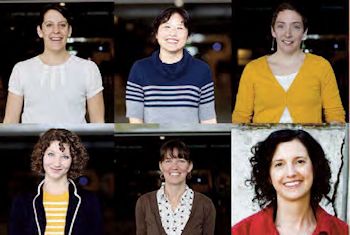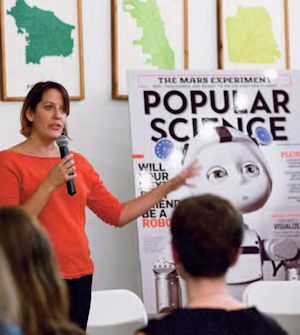SEJournal Online is the digital news magazine of the Society of Environmental Journalists. Learn more about SEJournal Online, including submission, subscription and advertising information.
Freelance Files
By AMY WESTERVELT
 |
| Climate Confidential’s team of journalists (clockwise from top left): Amy Westervelt, Ucilia Wang, Celeste LeCompte, Erica Gies, Mary Catherine O’Connor and Josie Garthwaite. Photo: Dan Fletcher, Beacon |
Six years ago, a fellow freelancer asked me if I’d be interested in contributing to a new online journalism venture.
It wouldn’t pay much to start, but it was by journalists for journalists and we were gonna take things into our own hands and figure out this whole digital media business model once and for all.
We tried everything. We brought on famous (to us) writers; we created a membership structure that included prizes for various levels (it’s true! before Kickstarter!); we dabbled with advertising and launched an aggressive social media campaign.
And ultimately, we failed.
There were too many writers to feed and we couldn’t grow our subscriber base quickly enough to match.
A year later, as the managing editor of an environmental journal, I worked with crowdfunding journalism startup Spot.us to augment our paltry rates and pay great reporters what they were worth ... or at least closer to it. Eventually, Spot.us closed shop, too.
Over the past few years, I’ve supported half a dozen friends’ book and film projects on Kickstarter and Indiegogo to varying degrees of success.
So when Dan Fletcher, a former TIME and Facebook staffer who had co-founded a journalism startup called Beacon, approached me about starting a reader-funded blog on his site last year, I said sure with enthusiasm, but very little optimism.
Nothing they were doing sounded dramatically different than what I’d seen before. But five years and various failed attempts after my first crowdfunding experiment I still liked the idea of journalists trying to figure out the business side for themselves.
Selling our ‘orphans’ went better than expected
With very little selling on my part, I managed to get 30 "subscribers" who paid me a total of around $100 a month for four stories. It was peanuts, but it was also a place where I could put stories killed at the last minute, rants I’d been mulling, interviews that had wound up on the cutting room floor or breaking news I couldn’t pitch quickly enough to another outlet.
When another environmental journalist, Celeste LeCompte, mentioned she was considering a Beacon blog too, we got to talking about banding together. It turned out Fletcher had already been thinking about content hubs and group projects.
We put a call out for additional reporters and rustled up four more environmental reporters – Mary Catherine O’Connor, Josie Garthwaite, Ucilia Wang, and Erica Gies.
In the beginning we all thought of it in roughly the same way I’d first thought of my solo blog. We could put our orphans there – blessed darlings that had been cut or killed.
Beacon had changed its launch model, opting for time-limited campaigns along the lines of Kickstarter rather than ongoing fundraisers. That meant we had to figure out early on how much we wanted to pay ourselves for stories.
Initially we agreed that $100 each would be fine. Then we realized we were being ridiculous and bumped it up to $500 (and later to $650), setting our initial fundraising goal at $20,000.
Finally, we picked a name – Climate Confidential.
Then we had to get down to the business of selling ourselves, which we turned out to be better at than we’d anticipated.
Plenty of mentions, and some surprise donors
Each of us reached out to organizations and companies we’d worked with over the years, friends and family members, and media outlets we thought might be interested in what we were doing – ours was the first group to fundraise on Beacon; we were focused squarely on the intersection of technology and the environment, and we were all women.
 |
|
Climate Confidential co-founder Amy Westervelt, speaking at the organization's November 13th “Food Fight” in Brooklyn. Co-hosted by Modern Farmer and Popular Science, the event featured a series of discussions about cultured meat — meat created in a lab rather than on a farm — incorporating experts and stakeholders on all sides of the issue, including researchers, ranchers, tech CEOs, chefs and sustainable food experts. Photo by Mariya Pylayev, Climate Nexus |
There was enough there to get us some mentions, plus the Beacon guys were getting a fair amount of their own press, and mentioning us every chance they got. A few weeks in, we’d had mentions in the Columbia Journalism Review, Yale Climate Connections, Tech Crunch, and The New York Times.
One company – Intel – gave us $5,000 as a launch sponsor. We made it abundantly clear that they would have no input editorially, offering them the chance to have a presence at our launch event instead.
One family member stumped up for another $5,000 package, then three separate individual donors joined in – each at the $5,000 level and each unknown to us.
Two turned out to be serial investors in journalism experiments; women who had worked in journalism and who now had the means to support new endeavors. The third was a National Renewable Energy Lab scientist who liked the idea of targeted technology and environment coverage, and wanted to give us the inside scoop.
Between the big sponsors and the hundreds of subscriptions we sold (more than 800), we raised nearly $47,000 in our launch month – clearly teaming up made us more successful than any one of us would’ve been alone.
Getting down to business; lessons learned
At that point we realized we needed to do this for real. We quickly set about figuring out an editorial structure that would enable four of us to write each month, while two managed editorial and promotional duties.
We set an editorial calendar. We created our own off-Beacon website. And then we started thinking about how we could turn it into a sustainable project. We still haven’t figured that out, but we’ve learned a lot along the way:
-
Lesson One: Your content is your most valuable asset — use it in multiple ways. Just as individual freelancers will occasionally take low-paid assignments to boost their visibility, we saw an opportunity to use some of our content to raise our profile, releasing one story per month to the Creative Commons.
The Creative Commons license allows others to share our work for free, but not sell it or publish it without credit. These stories got picked up by multiple publishers, including The Atlantic, Scientific American, Smithsonian, and Pacific Standard.
That, in turn, enabled us to go to other publishers with the idea of exclusively co-producing features with them. These stories are released on our Beacon site and on the co-publisher’s site at the same time. Co-publishers pay us their going rate for a web story, which enables us to augment the pay the writer receives and supplement the Climate Confidential general fund as well.
-
Lesson Two: You can’t escape the business side. Most journalism projects that fail do so because no one is willing, or able, to take on business development. It’s hard for most journalists to put on the sales and marketing hat.
We were lucky to have a few of these skills in our team, but it wasn’t something we thought about in the beginning, which could have been a real problem. In addition to the skills, you need to have the time – lots of it, unpaid – to devote to growing your business.
-
Lesson Three: Don’t be afraid to try everything and fail often. Like any other startup – maybe even more so given that we’re up against an entrenched and failing system – journalism startups need to be relatively fearless in their approaches. That means a lot of failure, testing boundaries and, occasionally, success.
We’ve tried everything including events, partnerships, newsletters and social media pushes, and are now mulling the ideas of accepting advertising, moving to a new platform, selling single issues or stories and offering a mobile app.
Funding options have grown
These days there are more options available to journalists looking for new ways to fund their reporting habits.
Beacon, Indiegogo, HatchFund, Kickstarter and Patreon all allow individuals and groups of journalists to raise funds, either one time for a particular project, to augment a project (SEJ-er Daniel Grossman raised $18,000 on Indiegogo recently to cover travel expenses for an oil sands reporting project, for example), or in an ongoing capacity.
Note that while most crowdfunding sites make you set a target and only fund your work if that target is reached, IndieGoGo gives you the funds raised, minus an additional fee if you don’t meet your target.
Then there are nonprofits funding reporting (see our separate features on nonprofits in this issue, "Can Nonprofit News Rescue Environmental Journalism?" and "Old-School Reporting in a New-Style Package"). The Food and Environment Reporting Network (FERN), for example, pays writers $1 a word for long features, which it then places in national media outlets.
Some reporting groups, like The Story Group, have cobbled together crowdfunding and nonprofit foundation support, each fueling the other – foundations like the reader support evidenced by successful crowdfunding; readers like the credibility that foundation backing brings; both like that their dollars stretch further.
Whatever you decide to do, know that it will be a lot of work, but that work can pay off.
Amy Westervelt is a writer and editor covering the environment, health, tech and business, primarily for The Guardian UK and The Wall Street Journal. Her work has also recently been published by Fast Company, Smithsonian, and Sierra magazine. In 2007, she won a Folio Eddie for her feature on the potential of algae as a feedstock for biofuel. Her website is amywestervelt.com.
* From the quarterly newsletter SEJournal, Winter 2015. Each new issue of SEJournal is available to members and subscribers only; find subscription information here or learn how to join SEJ. Past issues are archived for the public here.











 Advertisement
Advertisement 



